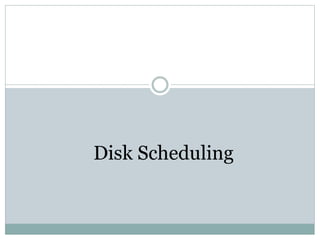
Disk Scheduling
- 2. Process B reads tracks 3, 5 Process A reads tracks 2, 5 Process C reads tracks 8, 4 OS has to read these tracks: 2,3,4,5,8. Disk Scheduling At runtime, I/O requests for disk tracks come from the processes OS has to choose an order to serve the requests
- 3. Access time Total access time = seek time + rotational delay + data transfer time Seek time – time required to move the disk arm to the required track Rotational delay – time required to rotate the disk to the required sector Data transfer time – time to read/write data from/to the disk
- 4. Disk Scheduling The order that the read/write head is moved to satisfy several I/O requests determines the total seek time affects performance the OS cannot change the rotational delay or transfer time, but it can try to find a ‘good’ order that spends less time in seek time. If requests are selected randomly, we will get the worst possible performance...
- 5. Disk Scheduling Policy FIFO: fair, but near random scheduling SSTF: possible starvation SCAN: favor requests for tracks near the ends C-SCAN FSCAN: avoid “arm stickiness” in SSTF, SCAN and C-SCAN
- 6. Disk Scheduling Policies First-in, first-out (FIFO) Process request sequentially Fair to all processes Approaches random scheduling in performance if there are many processes Example: 55, 58, 39, 18, 90, 160, 150, 38, 184
- 7. Disk Scheduling Policies Shortest Service/Seek Time First Select the disk I/O request that requires the least movement of the disk arm from its current position Always choose the minimum seek time Example: 55, 58, 39, 18, 90, 160, 150, 38, 184 Requests for tracks far away from the current position may never be served, if requests for closer tracks are issued continuously
- 8. Disk Scheduling Policies SCAN (aka Elevator Algorithm) Arm moves in one direction only, satisfying all outstanding requests until it reaches the last track in that direction Direction is reversed Example: 55, 58, 39, 18, 90, 160, 150, 38, 184
- 9. Disk Scheduling Policies C-SCAN Restricts scanning to one direction only When the last track has been visited in one direction, the arm is returned to the opposite end of the disk and the scan begins again In case of repetitive requests to one track, we will see “arm stickiness” in SSTF, SCAN, C-SCAN
- 10. FSCAN “Arm stickiness” in SSTF, SCAN, C-SCAN in case of repetitive requests to one track FSCAN uses two queues. When a SCAN begins, all of the requests are in one of the queues, with the other empty. During the scan, all new requests are put into the other queue. Service of new requests is deferred until all of the old requests have been processed.
- 12. Trace the policies FIFO, SSTF, SCAN, C-SCAN and FSCAN for the following disk requests. Each I/O request on a track takes 5 time units. At time 0, the disk starts reading track 10, and the read/write head was moving to the larger track number direction . Example Time 0 1 2 3 6 7 Request to access track .. 10 19 3 14 12 9 Track access order Average seek length FIFO 10,19,3,14,12,9 (9+16+11+2+3)/5 = 8.2 SSTF 10,14,12,9,3,19 (4+2+3+6+16)/5 = 6.2 SCAN 10,14,19,12,9,3 (4+5+7+3+6)/5 = 5 C-SCAN 10,14,19,3,9,12 (4+5+16+6+3)/5 = 6.8 FSCAN 10,14,19,3,9,12 (4+5+16+6+3)/5 = 6.8
- 13. RAID Redundant Array of Independent Disks A set of physical disk drives viewed by the OS as a single logical drive Data are distributed across the physical drives. May improve performance. Redundant disk stores parity information. Recoverability, reliability.
- 14. RAID 0 (Non-redundant) The logical disk is divided into strips, mapped round robin to consecutive physical disks Improve performance in disk read/write Not fault tolerant
- 15. RAID 1 (Mirrored) Each disk is mirrored by another disk Good performance if the hardware supports concurrent read/write to the mirrored pair Reliable, but expensive
- 16. Parity strip Computed and updated at write, verified at read Every write results in two read and two write of strips A corrupted strip can be recovered To compute the parity strip... P(0-3) := b0 b1 b2 b3 To recover the block 0... b0 = P(0-3) b1 b2 b3
- 17. RAID 5 (Block-level distributed parity) Having all parity strips on one disk may make it a bottleneck. Instead, we can distribute the parity strips among the disks If a single disk fails, the system can regenerate the data lost Reliable. Good performance with special hardware
- 18. Block-oriented disk Disk is block-oriented. One sector is read/written at a time. In PC, a sector is 512 byte The term cache memory is usually used to apply to a memory that is smaller and … while (!feof(F)) { // read one char fscanf(F, “%c”, &c); … }
- 19. Disk Cache Buffer in main memory for disk sectors Contains a copy of some of the sectors The term cache memory is usually used to apply to a memory that is smaller and … The term cache memory … … memory that is smaller Disk cache Disk Disk I/O requests
- 20. Disk Cache, Hit and Miss When an I/O request is made for a particular sector, the OS checks whether the sector is in the disk cache. If so, (cache hit), the request is satisfied via the cache. If not (cache miss), the requested sector is read into the disk cache from the disk.
- 21. Disk Cache, Replacement Least Recently Used (LRU) Replace the block that has been in the cache the longest with no reference Least Frequently Used (LFU) Replace the block that has experienced the fewest references
- 22. Thank You 22
